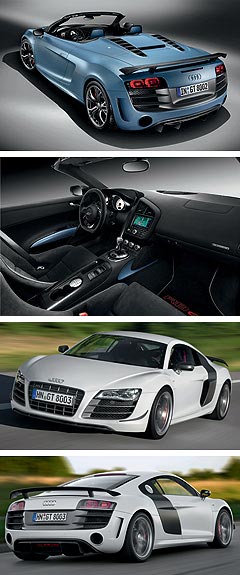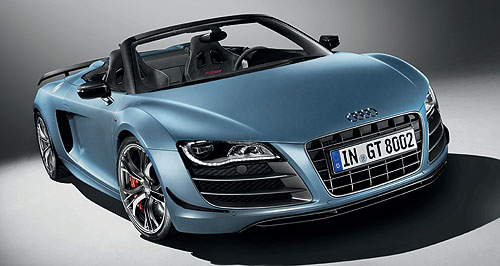Future models - Audi - R8 - GT SpyderAlong came an Audi SpyderVenomous: Production of Audi's scintillating R8 GT Spyder will be limited to just 333 - five of which are headed here. Audi produces a roadster version of its potent R8 GT6 Jun 2011 AUDI’S most potent road car has just been given an injection of sex appeal with the unveiling of the open-top version, the R8 GT Spyder, which becomes one of the quickest convertibles in the world. Based on the lightweight coupe released only a year ago, the Lamborghini V10-engined Audi will be produced in limited numbers, with production set to be capped at just 333 units – the same as the GT coupe. Five examples have been secured by Audi Australia, which expects to have them all pre-ordered before they finally arrive here some time in 2012. This is the same production number and Australian allocation of the GT coupe, which made its global debut at the Paris motor show last October. While the local price of the ultra-exclusive convertible has not yet been revealed, the price in Germany is €207,800 ($A282,900), which is €14,800 (or 7.7 per cent) more than the coupe version. Given that the coupe sells in Australia for $440,000, a similar premium would see the R8 GT Spyder carry a sticker price of about $475,000. Weighing 85kg less than the regular mid-engined R8 V10 Spyder, the new GT Spyder will accelerate from 0-100km/h in a just 3.8 seconds, 0.2s slower than the GT coupe but blitzing most of its ‘mainstream’ supercar convertible opposition.  Left: Audi R8 GT Spyder. Below: Audi R8 GT coupe. Left: Audi R8 GT Spyder. Below: Audi R8 GT coupe.Nothing, though, comes even close to the thousand-horsepower Bugatti Veyron 16.4 Grand Sport roadster, which completes the dash in a claimed 2.5 seconds. Audi’s new all-wheel drive flagship convertible is mechanically identical to the R8 GT coupe, including the 412kW/540Nm direct-injection 5.2-litre engine, and is draped in the same carbon-fibre-reinforced polymer (CFRP) bodywork. However, the necessary roof mechanism and extra structural bracing mean that at 1640kg the soft-top tips the scales some 115kg higher than the hardtop version. Although the roof is a relatively lightweight fabric unit rather than a folding metal unit, the R8 roadster carries an electro-hydraulic mechanism that raises or lowers the roof in just 19 seconds (even at speeds of up to 50km/h), a powered glass rear window that retracts into the rear bulkhead and an automatic rollover protection system. With a top speed of 317km/h, the convertible tops out 3km/h shy of the equivalent coupe. The car’s aluminium spaceframe chassis, which weighs 214kg, is assembled predominantly by hand in the R8 workshop at Audi’s Neckarsulm plant and final assembly of the car takes place in the same way. In addition to saving 5.5kg by using an engine frame made of magnesium and body elements made from CFRP, the Audi engineers also trimmed weight from the technical components in the transmission, wheels and brakes, then saved some 31.5kg by replacing the seats with buckets made from glass fibre-reinforced polymer (GFRP). Compared with the regular R8 Spyder, the GT version differs visually in having contrasting titanium grey trim elements, a front splitter with a dual lip, red GT badges, round exhaust tailpipes, an enlarged diffuser and dark LED tail-lights in a clear-glass design. Like the GT coupe, the Spyder’s dry sump 5.2-litre V10 engine produces 28kW more power and 10Nm more torque than the regular R8’s Lambo-based engine for a total of 412kW and 540Nm at 6500rpm. Power is put to the ground through all four wheels via a six-speed R tronic sequential manual transmission driving through an electro-hydraulic clutch. Audi’s familiar quattro permanent all-wheel drive system has a strong rear-wheel bias in the R8 GT and there is a limited slip differential at the rear to improve high-speed traction and stability. Suspension is by aluminium double wishbones on all four corners, the power steering is by rack-and-pinion and the 19-inch wheels (with 235/35 tyres up front and 295/30 tyres at the rear) cover large, lightweight carbon-fibre/ceramic brake discs.  Read more29th of September 2010  Audi 2010 R8 GTAll future models Alfa Romeo Alfa Romeo Abarth Abarth Audi Audi Aston Martin Aston Martin BMW BMW Bentley Bentley Chrysler Chrysler Chevrolet Chevrolet Dodge Dodge Citroen Citroen Ferrari Ferrari DS DS Ford Ford Fiat Fiat FPV FPV Foton Foton Haval Haval Great Wall Great Wall Honda Honda Holden Holden Hyundai Hyundai HSV HSV Isuzu Isuzu Infiniti Infiniti Jeep Jeep Jaguar Jaguar Lamborghini Lamborghini Kia Kia Lexus Lexus Land Rover Land Rover Mazda Mazda Maserati Maserati Mercedes-Benz Mercedes-Benz McLaren McLaren Mini Mini Nissan Nissan Mitsubishi Mitsubishi Peugeot Peugeot Opel Opel Proton Proton Porsche Porsche Renault Renault Ram Ram Saab Saab Rolls-Royce Rolls-Royce Smart Smart Skoda Skoda Subaru Subaru SsangYong SsangYong Tesla Tesla Suzuki Suzuki Toyota Toyota Volvo VolvoR8 pricing
Motor industry news |
Click to shareAudi modelsAll future models Alfa Romeo Alfa Romeo Abarth Abarth Audi Audi Aston Martin Aston Martin BMW BMW Bentley Bentley Chrysler Chrysler Chevrolet Chevrolet Dodge Dodge Citroen Citroen Ferrari Ferrari DS DS Ford Ford Fiat Fiat FPV FPV Foton Foton Haval Haval Great Wall Great Wall Honda Honda Holden Holden Hyundai Hyundai HSV HSV Isuzu Isuzu Infiniti Infiniti Jeep Jeep Jaguar Jaguar Lamborghini Lamborghini Kia Kia Lexus Lexus Land Rover Land Rover Mazda Mazda Maserati Maserati Mercedes-Benz Mercedes-Benz McLaren McLaren Mini Mini Nissan Nissan Mitsubishi Mitsubishi Peugeot Peugeot Opel Opel Proton Proton Porsche Porsche Renault Renault Ram Ram Saab Saab Rolls-Royce Rolls-Royce Smart Smart Skoda Skoda Subaru Subaru SsangYong SsangYong Tesla Tesla Suzuki Suzuki Toyota Toyota Volvo VolvoR8 pricing
Motor industry news |














Facebook Twitter Instagram